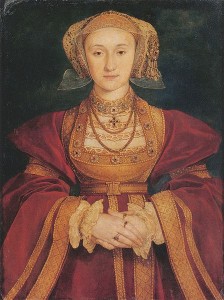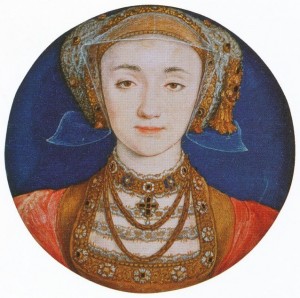 Thank you to Heather Darsie for sharing this article on Anne of Cleves with us today. Heather is busy researching Anne at the moment and is finding her a fascinating woman. By the way, “Anna, Tochter von Kleve” means “Anne, daughter of Cleves”.
Thank you to Heather Darsie for sharing this article on Anne of Cleves with us today. Heather is busy researching Anne at the moment and is finding her a fascinating woman. By the way, “Anna, Tochter von Kleve” means “Anne, daughter of Cleves”.
July 16, 2015 marks the 458th anniversary of Anna von Kleve’s death. Anna died of a declining illness and was buried in Westminster Abbey.1 Anna’s illness, which was suspected to be cancer, began in early 1557.2 After her death on July 16, 1557 at Chelsea, Anna was buried on August 3, 1557 near Edward the Confessor’s shrine.3 Mary I, executrix of Anna’s will,4 saw to it that Anna’s
“…magnificent funeral was conducted according to Catholic rites as [Anna] had wanted. [Her] …monument is a low stone structure of three sections with carvings showing her initials AC with a crown, lions’ heads and skulls and crossed bones (symbols of mortality).”5
So who was this woman, who could call on none other than a queen of England to act as executrix of her will?
More commonly known as Anne of Cleves or the fourth wife of Henry VIII, Anna von Jülich-Kleve-Berg was born on September 20, 1515 in Düsseldorf to Johann III von Jülich-Kleve-Berg and his wife Maria von Berg; Anna was their second daughter.6 Anna was given an old-fashioned education, with an emphasis on domestic skills.7 Johann III was known during his reign as Johann the Peaceful.8 Johann held a close rapport with Erasmus of Rotterdam, even giving Erasmus a pension in April of 1533.9 As religious reform was creeping through the various Germanic duchies, Johann sought to preserve tolerance within his borders by creating church regulations.10 Johann worked closely with Erasmus in creating the church regulations that were decreed in 1533.11 In February 1538, Johann, originally Johann the Peaceful, died being known as Johann the Peace-Maker.12
Anna was raised mostly by her mother, Maria von Berg, with whom Anna enjoyed a close relationship.13 Maria, a strong-willed woman, was a devout Catholic.14 Between Anna being raised by her Catholic mother and Anna’s father holding Erasmus, and not Martin Luther, in close confidence, it was likely that Anna was at least raised as a Catholic. Due to Anna’s upbringing, close relationship with Mary I of England and Anna’s Catholic funeral, it is certainly conceivable that Anna was not a Protestant.15
Anna did not receive a Renaissance education, as was popular in England at the time.16 As a result, Anna could read and write in her native German, but could not speak any foreign languages.17 Anna was not taught how to play or sing music, either.18 However, Anna did become a skilled embroiderer and seamstress.19 Despite Anna’s lack of linguistic or musical accomplishments, she still impressed the English ambassadors with her intelligence:
“Her witte is so goode that no doubt she wille yn a short space lerne th’Englissh tongue, when so ever she puttithe her mind to hit.”20
She went on to learn English with shocking alacrity.21 Anna, although a bit sheltered, was a sharp young woman.

Sybille (1512-1554), Anna’s older sister, married Johann Friedrich, who was the Elector of Saxony. Johann Friedrich was also a member of the powerful Schmalkaldic League, which boasted of Germanic princes, counts, the French and Danish kings, almost thirty Imperial and Hanseatic cities, and over forty Protestant theologians, imperial envoys, and the Pope attending the Schmalkaldic federal assembly which took place in winter 1537.26 Anna’s younger brother, Wilhelm V (1516-1592), married the Holy Roman Emperor’s niece, Maria of Austria.27 Anna’s younger sister Amalia (1517-1586) has been described as having a strong personality; she went on to write poetry at the least and draft an entire songbook at most.28 All of Anna’s siblings went on to either have brilliant marriages, be part of successful kingdoms or duchies, or contribute to Germanic culture and literature.
So, who was Anna von Kleve? She was a wonderfully intelligent, witty woman. She wore extravagant clothes and enjoyed a close relationship with her mother. Anna was the daughter, sister, and wife of powerful European rulers. She was a catholic. She was polite, savvy and a true gentlewoman, with a French ambassador stating that, “…[All of Anna’s] affairs could never make her utter a word by which one might suppose that she was discontented.’”29 From her birth until her death, Anna was a remarkable Daughter of Cleves.
Notes and Sources
- “Anne of Cleves: Facts, Information, Biography & Portraits.” Accessed July 14, 2015. http://englishhistory.net/tudor/monarchs/anne-of-cleves/.
- “Anna von Kleve (1515-1557), Königin von England.” Accessed July 14, 2015. http://www.rheinische-geschichte.lvr.de/persoenlichkeiten/A/Seiten/AnnavonKleve.aspx
- “Tudor Tombs and Burials: Anne of Cleves.” Accessed July 14, 2015. http://onthetudortrail.com/Blog/resources/tudor-tombs-and-burials/
- Strickland, Agnes. Lives of the Queens of England. Vol. III. (London: Longman, Brown, Green, Longman, & Roberts 1857). 94.
- “Anne of Cleves, 4th Wife of Henry VIII.” Accessed July 14, 2015. http://www.westminster-abbey.org/archive/our-history/royals/burials/anne-of-cleves,-4th-wife-of-henry-viii
- “Anna von Kleve (1515-1557), Königin von England.” Accessed July 14, 2015. http://www.rheinische-geschichte.lvr.de/persoenlichkeiten/A/Seiten/AnnavonKleve.aspx
- “Anne of Cleves: God Send Me Well to Keep.” Accessed July 14, 2015. http://tudorhistory.org/cleves/ See also, “Anne of Cleves: Facts, Information, Biography & Portraits.” Accessed July 14, 2015. http://englishhistory.net/tudor/monarchs/anne-of-cleves/.
- Withof, Johann Hildebrand. Chronik der Stadt Duisburg von Anfängen bis zum Jahre 1742. (Herstellung und Verlag: Books on Demand GmbH, Nordestedt; Albrecht Blank 2008). 196, footnote 276.
- “Johann III. Der Friedfertige.” Accessed July 15, 2015. http://www.hagen-bobzin.de/hobby/Johann_III_1539.html.
- Norton, Elizabeth. Anne of Cleves: Henry VIII’s Discarded Bride. (Gloucestershire: Amberley Publishing, The Hill, Stroud 2010). 11.
- Norton, 11. See also, “Johann III. Der Friedfertige.” Accessed July 15, 2015. http://www.hagen-bobzin.de/hobby/Johann_III_1539.html.
- “Johann III. Der Friedfertige.”
- Norton, 10-11.
- “Johann III. Der Friedfertige.”
- Norton, 11.
- “Elizabethan Women: the Role of Elizabethan Women – Education – the Nobility.” Accessed July 15, 2015. http://www.william-shakespeare.info/elizabethan-women.htm
- “Anna von Kleve (1515-1557): Das Beste aus jeder Situation machen.” Accessed July 15, 2015. http://www.kleio.org/de/geschichte/frauen/a_kleve.html
- Norton, 11.
- “Anna von Kleve (1515-1557): Das Beste aus jeder Situation machen.”
- Dr. Alfred Woltmann. Holbein and His Times, trans. F. E. Bunnètt (London: Richard Brentley and Son, New Burlington Street,1872), 435-436. This description of Anna is attributed to Nicholas Wotton, in a letter written to Henry VIII concerning Wotton’s perception of Anna.
- “Anne of Cleves.” Accessed July 15, 2015. http://www.newworldencyclopedia.org/entry/Anne_of_Cleves
- Please see, generally, “Renaissance.” Accessed July 15, 2015. http://www.historical-costumes.eu/en/02_renaissance.html; “Fashion of 16th Century.” Accessed July 15, 2015. http://www.thehistoryconnection.com/Fashion-Of-16th-Century.html.
- “Anne of Cleves.”
- “Anne of Cleves: Facts, Information, Biography & Portraits.” Accessed July 15, 2015. http://englishhistory.net/tudor/monarchs/anne-of-cleves/.
- Ibid.
- “Schmalkalden: Luther und der Schmalkaldische Bund.” Accessed July 15, 2015. http://www.luther-in-thueringen.com/de/schmalkalden.html
- Norton, 131.
- “Die Standhafte Amalia.” Accessed July 15, 2015. http://www.derwesten.de/staedte/nachrichten-aus-kleve-und-der-region/die-standhafte-amalia-id9436894.html
- “Anne of Cleves: Facts, Information, Biography & Portraits.”